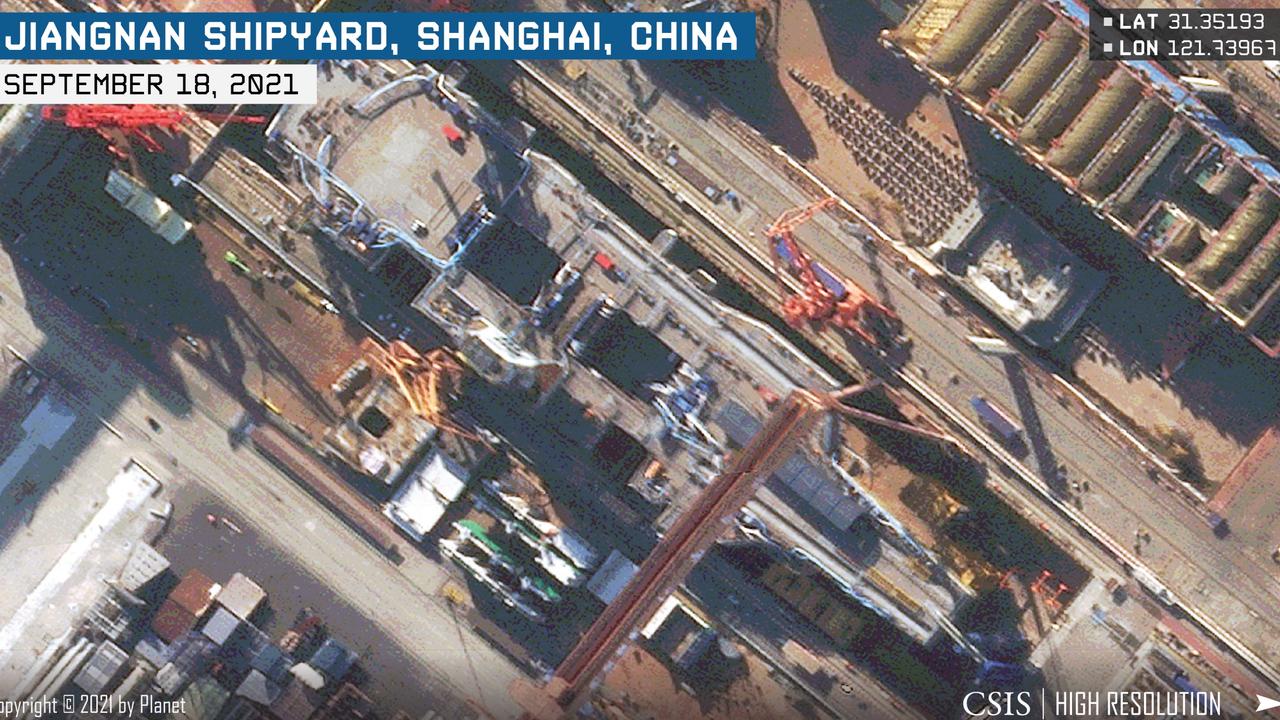Satellite photos reveal China plans to launch new aircraft carrier
Recent satellite photos of a Chinese shipyard have revealed Beijing’s plan to dominate the US could be just months away.
Innovation
Don't miss out on the headlines from Innovation. Followed categories will be added to My News.
Satellite photos reveal China’s enormous new aircraft carrier is on the brink of being launched as the ambitious superpower races to supplant the US as the Pacific’s dominant force.
The high-resolution images obtained by the Center for Strategic and International Studies (CSIS) focus on Beijing’s new Type 003 aircraft carrier under construction at the Jiangnan shipyard on the Yangtze River, Shanghai.
Taken late in October, they show the 330m-long hull is now essentially complete, with its flight deck fully enclosed and control-tower island fitted.


Work on the three catapults designed to launch heavily-laden aircraft into the air appears to be proceeding rapidly. Only a few other major systems, such as radars, weapons and the elevators used to move aircraft between decks, remain incomplete.
“Based on available information and observed progress at Jiangnan, the authors estimate that the Type 003 will launch in roughly three to six months,” the report concludes.
Type 003 is China’s third aircraft carrier. It is its second home-built effort. And it’s the first of comparable size and capability to the United States’ nuclear-powered designs.

The earlier carriers, Liaoning (Type 001) and Shandong (Type 002), are Cold War-era Soviet Union designs used by Beijing to train its embryonic carrier strike group crews.
Ready for launch
The aircraft carrier’s major internal works appear to have been completed in September/October. That’s when two large holes in the deck allowing access to the ship’s interior were plated over. This likely indicates that the engines and other large internal components have been fitted.
“The inclusion of catapults on Type 003 is a major leap forward for the People’s Liberation Army Navy (PLAN),” the report reads. Liaoning and Shandong use less-effective ski-jump style ramps to help sling aircraft into the air.
The Catapult Assisted Take-Off Arrested Recovery (CATOBAR) systems mean Type 003, which is yet to receive its formal name, will operate bigger and heavier aircraft than its predecessors.
“Most CATOBAR systems are steam-driven, but it is widely rumoured that China has developed an electromagnetic launch system similar to the one developed for the US Navy’s new Gerald R. Ford-class of carriers,” notes CSIS.
“This is a pretty significant step forward,” says CSIS senior fellow Matthew Funaiole. “They’ve really committed to building out a carrier program, and they continue to push the boundaries of what they’re able to do.”
Air activity
The United States Department of Defence has assessed that Type 003 will be fully ready for combat operations by 2024.
“This design will enable it to support additional fighter aircraft, fixed-wing early-warning aircraft, and more rapid flight operations and thus extend the reach and effectiveness of its carrier-based strike aircraft,” the 2021 annual report to Congress on the state of China’s military reads.
“The PRC’s second domestically built carrier is projected to be operational by 2024, with additional carriers to follow.”
The report finds the PLAN has also made great strides towards fielding new and capable aircraft to fly off the ship.
“In addition to the standard J-15, there is a catapult-capable J-15 variant in development,” it said. “The aircraft has tested from land-based steam and electromagnetic catapults at China’s Huangdicun test site.
A third J-15 variant, the J-15D, is a two-seat aircraft equipped with wingtip electronic support measures/electronic intelligence gathering pods as well as several conformal antennas.”
And there it is.
— Rick Joe (@RickJoe_PLA) October 29, 2021
J-XY/J-35.
When it rains it pours huh?
First J-20S a few days ago, now this.
Note the catapult launch bar, the wing fold line, and the chin EOIRST. pic.twitter.com/GuhuFZ1Syz
Open-source intelligence (OSINT) sources have also tracked Beijing’s progress in producing an early warning and command (AWACS) aircraft, the KJ-600. It began flight testing late last year.
And a contender for China’s next-generation carrier combat aircraft, the J-31, was captured on camera last month. Roughly the same size, weight and appearance as the US F-35 stealth fighter, the prototype appeared to have had the necessary strengthening and additional equipment essential for harsh aircraft carrier operating conditions.
The US Department of Defence also noted “development continues on the smaller FC-31/J-31 for export or as a future naval fighter for the PLAN’s next class of aircraft carriers”.
‘Bodyguard’ building
As Type 003 nears completion, a force of modern guided-missile cruisers is being rapidly built to act as its close escort. The recently completed fourth such ship, the Yanan, will be commissioned in December. A fifth, the Anshan, will follow suit early next year.
Three more are in the construction yards.
The 13,000 tonne, 180 metre long Type 055 warships are specifically designed to protect a fleet from sustained air and missile attack.

The cruisers (often incorrectly called destroyers) are fitted with 112 vertical launch (VLS) missile tubes, capable of carrying a variety of anti-air, anti-surface and land-attack weapons. Australia’s air warfare frigates (often called destroyers) have a 48-tube VLS.
“This warship is a bodyguard for China’s aircraft carriers and large amphibious helicopter landing platforms like the Type 075 and, in the future, the Type 076,” Beijing-based military analyst Li Jie recently told the South China Morning Post. “But it’s also capable of fighting alone or leading a small flotilla on the high seas.”
The United States navy’s equivalent, the Ticonderoga class guided-missile cruisers, are being withdrawn from service as they near the end of their operational lives. No replacements are currently being built.
Threat assessment
“The PRC’s aircraft carriers and planned follow-on carriers, once operational, will extend air defence coverage beyond the range of coastal and shipboard missile systems and will enable task group operations at increasingly longer ranges,” the US DoD report notes.
“The PLAN’s emerging requirement for sea-based land-attack systems will also enhance the PRC’s ability to project power. Furthermore, the PLAN now has a sizeable force of highly capable logistical replenishment ships to support long-distance, long-duration deployments, including two new Fuyu class fast combat support ships (AOEs) built specifically to support aircraft carrier operations.”
This, combined with its equally rapidly expanding fleet of large modern amphibious warships, will enable Beijing to deploy troops – or relief efforts – “wherever PRC interests are threatened or in support of PRC participation in international assistance operations”.
Jamie Seidel is a freelance writer | @JamieSeidel
Originally published as Satellite photos reveal China plans to launch new aircraft carrier









